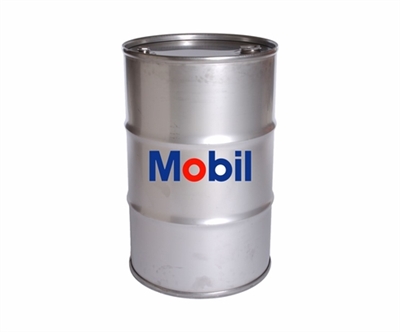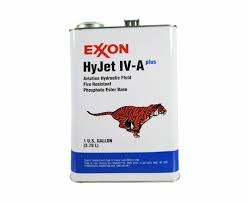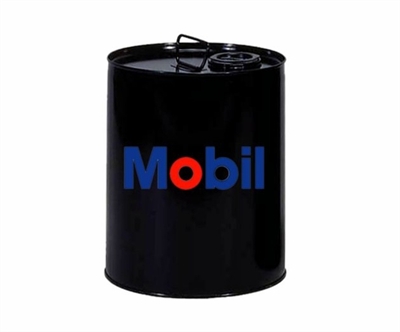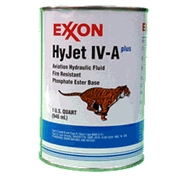SAE AS1241 Exxon HyJet IV-A plus Aviation Hydraulic Fluid-55GL
Description
SAE AS1241 Exxon HyJet IV-A plus Aviation Hydraulic Fluid-55GL Drum
Exxon HyJet IV-A plus is a fire-resistant phosphate ester hydraulic fluid designed for use in commercial aircraft. It is the best-performing Type IV fluid and approaches to a great extent many of the performance capabilities of Type V fluids, including high temperature stability, long fluid life, low density, and rust protection.
It is superior to all other Type IV fluids in these respects.
Exxon HyJet IV-A plus meets the specifications of all major aircraft manufacturers and SAE AS1241
To learn more, download the Exxon-Hyjet-IV-A-Plus-Fact-Sheet >>
SAE AS1241 Exxon HyJet IV-A plus Aviation Hydraulic Fluid offers the following key features and benefits:
| Features | Advantages and Potential Benefits |
|---|---|
| Best in high temperature stability among Type IV fluids | Longer fluid life. Lesser need to replace fluid due to degradation. Reduced hydraulic system maintenance costs |
| Lowest density Type IV fluid | Reduced weight of the hydraulic fluid carried by aircraft. Reduced aircraft fuel consumption, lower operating costs |
| Effective rust protection | Reduced the risk of equipment damage in the event of major water contamination |
| Excellent low temperature flow (viscosity) properties | Precise hydraulic system control and response even during extended range/polar flights. Longer equipment life |
| Excellent deposit control | Longer equipment life. Reduced maintenance costs |
| Excellent protection against electro-chemical corrosion (erosion) | Protection against servo valve and pump damage |
| Approved by all major aircraft manufacturers | Use as fleet lubricant by airline operators |
| Fully compatible with all approved phosphate ester hydraulic fluids | Flexibility in use by airline operators |
Applications of SAE AS1241 Exxon HyJet IV-A plus Aviation Hydraulic Fluid
Exxon HyJet IV-A plus fire-resistant aviation hydraulic fluid is used in commercial aircraft hydraulic systems where phosphate hydraulic fluids are recommended. It is compatible in all proportions with commercial Type IV and Type V phosphate ester aviation hydraulic fluids.
Exxon HyJet IV-A plus meets or exceeds the following industry and aircraft builder specifications. It is approved against all commercial aircraft manufacturer requirements and is included in their Qualified Products Lists.
Specifications and Approvals of SAE AS1241 Exxon HyJet IV-A plus Aviation Hydraulic Fluid
| HyJet IV-A plus | Meets Type lV, Low density | Is in Qualified products List |
|---|---|---|
| SAE Aerospace Standard AS1241C | X | Not Applicable |
| Airbus NSA307110N | X | X |
| ATR NSA307110N | X | X |
| Boeing BMS 3-11P, Type IV, Class 1 and Type V, Grade B and Grade C Â | X | X |
| Boeing (Douglas Division) DMS 2014H | X | X |
| British Aerospace (Avro) BAC.M.333C | X | X |
| Bombardier/Canadair BAMS 564-003A | X | X |
| Bombardier/DeHavilland | X | X |
| Cessna | X | X |
| Embraer | X | X |
| Fokker | X | X |
| Gulfstream Aerospace 1159SCH302J | X | X |
| Lockheed C-34-1224C | X | X |
Typical Properties – SAE AS1241 Exxon HyJet IV-A plus Aviation Hydraulic Fluid
| Test Method | HyJet IV-A plus (1) | Limits | |
|---|---|---|---|
| Kinematic Viscosity, cSt | ASTM D 445 | ||
| at -53.9ºC (-65ºF) | 1320 | 2000 max | |
| at -26.1ºC (-15ºF) | 130 | 135 max | |
| at 37.8ºC (100ºF) | 10.6 | 10.0 -11.0 | |
| at 98.9ºC (210ºF) | 3.6 | 3.35 – 3.75 | |
| at 127.6ºC (260ºF) | 2.6 | 1.5 min | |
| Viscosity Index | ASTM D 2270 | 280 | |
| Shear Stability, % Viscosity Drop at 40ºC | ASTM D 5621 | 22 | |
| Pour Point, ºC (ºF) | ASTM D 97 | ‹-62 (-80) | -62 (-80) max |
| Specific Gravity at 25ºC/25ºC (77ºF/77ºF) | ASTM D 4052 | 0.996 | 0.990 -1.002 |
| Density at 15.6ºC (60ºF), g/mL (lb/gal) | ASTM D 4052 | 0.999 (8.35) | |
| Acid Number, mg KOH/g | ASTM D 974 | 0.04 | 0.1 max |
| Water, Karl Fischer, mass % | ASTM D 6304 | 0.1 | 0.2 max |
| Flammability | |||
| Flash Point, ºC (ºF) | ASTM D 92 | 176 (349) | 160 (320) min |
| Fire Point, ºC (ºF) | ASTM D 92 | 188 (370) | 177 (350) min |
| Autoignition Point, ºC (ºF) | ASTM D 2155 | ›427 (800) | 400 (752) min |
| Foaming Tendency/Stability, mL foam/sec to collapse | ASTM D 892 | ||
| Sequence I | 27/15 | 250/100 max | |
| Sequence Il | 23/13 | 150/50 max | |
| Sequence Ill | 28/16 | 450/250 max | |
| Particle Count, NAS 1638 Class | Auto Counter | 4 | 7 max |
| Chemical Elements, ppm | |||
| Calcium | 103 | 120 max | |
| Potassium | 38 | 48 max | |
| Chlorine | 10 | 50 max | |
| Sodium | 1 | 15 max | |
| Sulfur | 224 | 350 max | |
| Four-Ball Wear, Scar diameter at 75ºC/600rpm/1hour, mm | Modified ASTM D 4172 | ||
| 4 kg | 0.22 | 0.45 max | |
| 10 kg | 0.33 | 0.50 max | |
| 40 kg | 0.73 | 0.55 – 0.85 | |
| Electrical Conductivity at 20ºC, microSiemens/cm | 1.4 | 0.5 min | |
| Bulk Modulus, Isothermal secant at 100ºF/3000 psi, psi | 210,000 | ||
| Thermal Conductivity at 40ºC, cal/sec/cm2/ºC (Btu/hr/ft2/ºF) | 33×10^-5 (0.0799) | ||
| Coefficient of Thermal Expansion, 25 to 100ºC, per ºC (per ºF) | 0.00086 (0.00048) | ||
| Specific Heat Capacity at 40 ºC, cal/g/ºC (same as Btu/lb/ºF) | 0.41 |
(1) Values may vary within modest ranges
Additional information
| Weight | 460 lbs |
|---|
You must be logged in to post a review.





Reviews
There are no reviews yet.